Yamaha EZ-AG User Manual
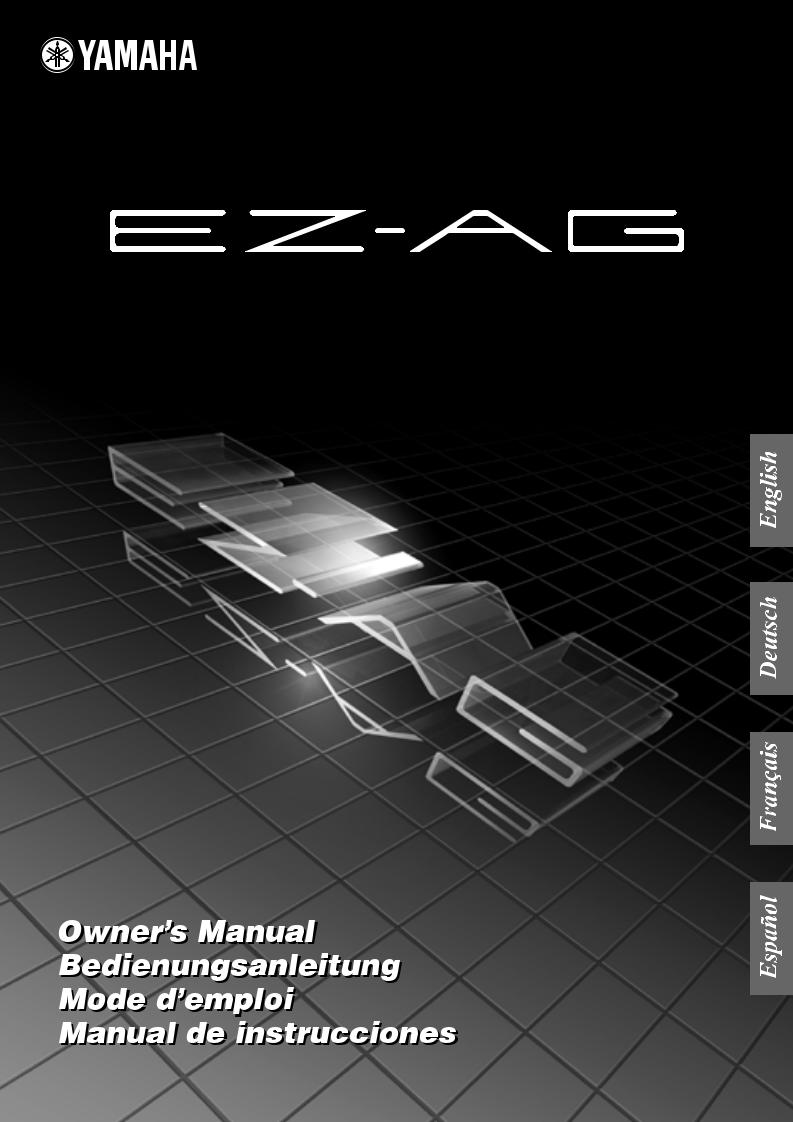
EZ GUITAR / EZ GITARRE / EZ GUITARE / EZ GUITARRA
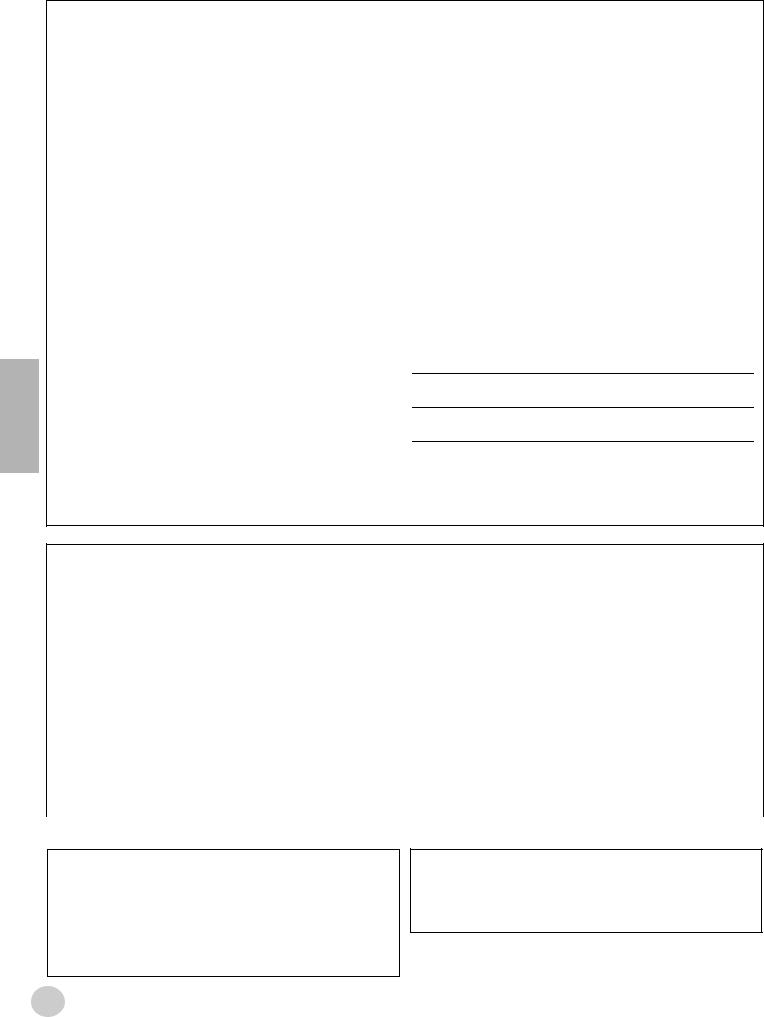
SPECIAL MESSAGE SECTION
This product utilizes batteries or an external power supply (adapter). DO NOT connect this product to any power supply or adapter other than one described in the manual, on the name plate, or specifically recommended by Yamaha.
This product should be used only with the components supplied or; a cart, rack, or stand that is recommended by Yamaha. If a cart, etc., is used, please observe all safety markings and instructions that accompany the accessory product.
SPECIFICATIONS SUBJECT TO CHANGE:
The information contained in this manual is believed to be correct at the time of printing. However, Yamaha reserves the right to change or modify any of the specifications without notice or obligation to update existing units.
This product, either alone or in combination with an amplifier and headphones or speaker/s, may be capable of producing sound levels that could cause permanent hearing loss. DO NOT operate for long periods of time at a high volume level or at a level that is uncomfortable. If you experience any hearing loss or ringing in the ears, you should consult an audiologist. IMPORTANT: The louder the sound, the shorter the time period before damage occurs.
NOTICE:
Service charges incurred due to a lack of knowledge relating to how a function or effect works (when the unit is operating as designed) are not covered by the manufacturer’s warranty, and are therefore the owners responsibility.
Please study this manual carefully and consult your dealer before requesting service.
This product may also use “household” type batteries. Some of these may be rechargeable. Make sure that the battery being charged is a rechargeable type and that the charger is intended for the battery being charged.
When installing batteries, do not mix batteries with new, or with batteries of a different type. Batteries MUST be installed correctly. Mismatches or incorrect installation may result in overheating and battery case rupture.
Warning:
Do not attempt to disassemble, or incinerate any battery. Keep all batteries away from children. Dispose of used batteries promptly and as regulated by the laws in your area. Note: Check with any retailer of household type batteries in your area for battery disposal information.
Disposal Notice:
Should this product become damaged beyond repair, or for some reason its useful life is considered to be at an end, please observe all local, state, and federal regulations that relate to the disposal of products that contain lead, batteries, plastics, etc. If your dealer is unable to assist you, please contact Yamaha directly.
NAME PLATE LOCATION:
The name plate is located on the bottom of the product.The model number, serial number, power requirements, etc., are located on this plate. You should record the model number, serial number, and the date of purchase in the spaces provided below and retain this manual as a permanent record of your purchase.
ENVIRONMENTAL ISSUES:
Yamaha strives to produce products that are both user safe and environmentally friendly. We sincerely believe that our products and the production methods used to produce them, meet these goals. In keeping with both the letter and the spirit of the law, we want you to be aware of the following:
Battery Notice:
This product MAY contain a small non-rechargeable battery which (if applicable) is soldered in place. The average life span of this type of battery is approximately five years. When replacement becomes necessary, contact a qualified service representative to perform the replacement.
Model
Serial No.
Purchase Date
92-BP (bottom)
PLEASE KEEP THIS MANUAL
FCC INFORMATION (U.S.A.)
1. IMPORTANT NOTICE: DO NOT MODIFY THIS UNIT! |
with FCC regulations does not guarantee that interference will not occur in |
|
This product, when installed as indicated in the instructions contained in |
all installations. If this product is found to be the source of interference, |
|
this manual, meets FCC requirements. Modifications not expressly |
which can be determined by turning the unit “OFF” and “ON”, please try to |
|
approved by Yamaha may void your authority, granted by the FCC, to use |
eliminate the problem by using one of the following measures: |
|
the product. |
Relocate either this product or the device that is being affected by the |
|
|
||
2. IMPORTANT: When connecting this product to accessories and/or |
interference. |
|
another product use only high quality shielded cables. Cable/s supplied |
Utilize power outlets that are on different branch (circuit breaker or fuse) |
|
with this product MUST be used. Follow all installation instructions. Failure |
circuits or install AC line filter/s. |
|
to follow instructions could void your FCC authorization to use this product |
In the case of radio or TV interference, relocate/reorient the antenna. If the |
|
in the USA. |
||
antenna lead-in is 300 ohm ribbon lead, change the lead-in to co-axial |
||
|
||
3. NOTE: This product has been tested and found to comply with the |
type cable. |
|
requirements listed in FCC Regulations, Part 15 for Class “B” digital |
If these corrective measures do not produce satisfactory results, please |
|
devices. Compliance with these requirements provides a reasonable level |
contact the local retailer authorized to distribute this type of product. If you |
|
of assurance that your use of this product in a residential environment will |
can not locate the appropriate retailer, please contact Yamaha Corpora- |
|
not result in harmful interference with other electronic devices. This equip- |
tion of America, Electronic Service Division, 6600 Orangethorpe Ave, |
|
ment generates/uses radio frequencies and, if not installed and used |
Buena Park, CA90620 |
|
according to the instructions found in the users manual, may cause inter- |
The above statements apply ONLY to those products distributed by |
|
ference harmful to the operation of other electronic devices. Compliance |
||
Yamaha Corporation of America or its subsidiaries. |
||
|
||
|
|
|
* This applies only to products distributed by YAMAHA CORPORATION OF AMERICA. |
(class B) |
OBSERVERA!
Apparaten kopplas inte ur växelströmskällan (nätet) så länge som den ar ansluten till vägguttaget, även om själva apparaten har stängts av.
ADVARSEL: Netspæendingen til dette apparat er IKKE afbrudt, sålæenge netledningen siddr i en stikkontakt, som er t endt — også selvom der or slukket på apparatets afbryder.
VAROITUS: Laitteen toisiopiiriin kytketty käyttökytkin ei irroita koko laitetta verkosta.
Entsorgung leerer Batterien (nur innerhalb Deutschlands)
Leisten Sie einen Beitrag zum Umweltschutz. Verbrauchte Batterien oder Akkumulatoren dürfen nicht in den Hausmüll. Sie können bei einer Sammelstelle für Altbatterien bzw. Sondermüll abgegeben werden. Informieren Sie sich bei Ihrer Kommune.
(battery)
(standby)
2 EZ-AG

● COPYRIGHT NOTICE
Twelve of the demo-songs or compositions included in this instrument are as follows:
California Girls
Words and Music by Brian Wilson and Mike Love
Copyright © 1965 IRVING MUSIC, INC.
Copyright Renewed
All Rights Reserved Used by Permission
Day Tripper
Words and Music by John Lennon and Paul McCartney Copyright © 1965 Sony/ATV Songs LLC
Copyright Renewed
All Rights Administered by Sony/ATV Music Publishing, 8 Music Square West, Nashville, TN 37203
International Copyright Secured All Rights Reserved
Don’t Be Cruel (To A Heart That’s True)
Words and Music by Otis Blackwell and Elvis Presley
Copyright © 1956 by Unart Music Corporation and Elvis Presley Music, Inc.
Copyright Renewed and Assigned to Elvis Presley Music
All Rights Administered by Cherry River Music Co. and Chrysalis Songs
International Copyright Secured All Rights Reserved
A Hard Day’s Night
Words and Music by John Lennon and Paul McCartney Copyright © 1964 Sony/ATV Songs LLC
Copyright Renewed
All Rights Administered by Sony/ATV Music Publishing, 8 Music Square West, Nashville, TN 37203
International Copyright Secured All Rights Reserved
Hound Dog
Words and Music by Jerry Leiber and Mike Stoller
Copyright © 1956 by Elvis Presley Music, Inc. and Lion Publishing Co., Inc.
Copyright Renewed, Assigned to Gladys Music and Universal - MCA Music Publishing, A Division of Universal Studios, Inc.
All Rights Administered by Cherry Lane Music Publishing Company, Inc. and Chrysalis Music
International Copyright Secured All Rights Reserved
Knock On Wood
Words and Music by Eddie Floyd and Steve Cropper
Copyright © 1966 IRVING MUSIC, INC.
Copyright Renewed
All Rights Reserved Used by Permission
More Than Words
Words and Music by Nuno Bettencourt and Gary Cherone Copyright © 1990 COLOR ME BLIND MUSIC
All Rights Administered by ALMO MUSIC CORP. All Rights Reserved Used by Permission
(Sittin’ On) The Dock Of The Bay
Words and Music by Steve Cropper and Otis Redding Copyright © 1968, 1975 IRVING MUSIC, INC. Copyright Renewed
All Rights Reserved Used by Permission
Stand By Me
Words and Music by Ben E. King, Jerry Leiber and Mike Stoller © 1961 (Renewed) JERRY LEIBER MUSIC, MIKE STOLLER MUSIC and MIKE & JERRY MUSIC LLC
All Rights Reserved
Tears In Heaven
Words and Music by Eric Clapton and Will Jennings
Copyright © 1992 by E.C. Music Ltd. and Blue Sky Rider Songs
All Rights for E.C. Music Ltd. Administered by Unichappell Music Inc. All Rights for Blue Sky Rider Songs Administered by Irving Music, Inc. International Copyright Secured All Rights Reserved
Yesterday Once More
Words and Music by John Bettis and Richard Carpenter
Copyright © 1973 ALMO MUSIC CORP. and HAMMER AND NAILS MUSIC Copyright Renewed
All Rights Administered by ALMO MUSIC CORP. All Rights Reserved Used by Permission
You Are So Beautiful
Words and Music by Billy Preston and Bruce Fisher
Copyright © 1973 IRVING MUSIC, INC. and ALMO MUSIC CORP. Copyright Renewed
All Rights Reserved Used by Permission
All Rights Reserved, Unauthorized copying, public performance and broadcasting are strictly prohibited regarding the above twelve demo-songs.
COPYRIGHT NOTICE This product incorporates and bundles computer programs and contents in which Yamaha owns copyrights or with respect to which it has license to use others’ copyrights. Such copyrighted materials include, without limitation, all computer software, styles files, MIDI files, WAVE data and sound recordings. Any unauthorized use of such programs and contents outside of personal use is not permitted under relevant laws. Any violation of copyright has legal consequences. DON’T MAKE, DISTRIBUTE OR USE ILLEGAL COPIES.
1
EZ-AG 3
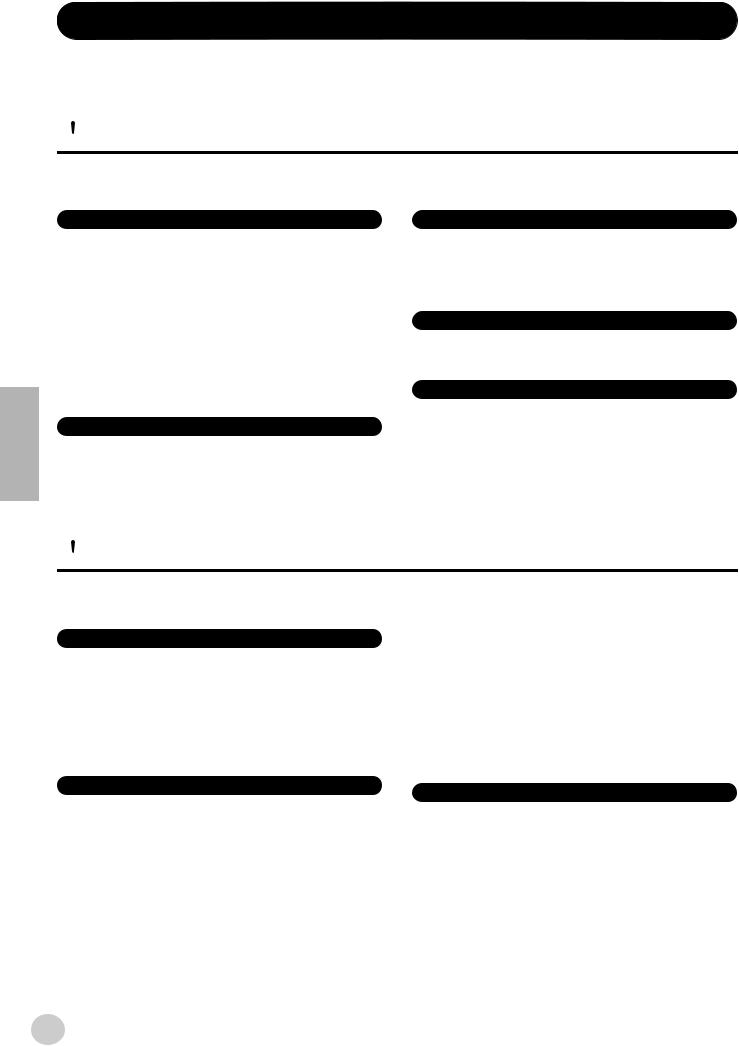
PRECAUTIONS
PLEASE READ CAREFULLY BEFORE PROCEEDING
* Please keep this manual in a safe place for future reference.
 WARNING
WARNING
Always follow the basic precautions listed below to avoid the possibility of serious injury or even death from electrical shock, short-circuiting, damages, fire or other hazards. These precautions include, but are not limited to, the following:
Power supply/AC power adaptor
•Only use the voltage specified as correct for the instrument. The required voltage is printed on the name plate of the instrument.
•Use the specified adaptor (PA-3C or PA-3B or an equivalent recommended by Yamaha) only. Using the wrong adaptor can result in damage to the instrument or overheating.
•Check the electric plug periodically and remove any dirt or dust which may have accumulated on it.
•Do not place the AC adaptor cord near heat sources such as heaters or radiators, and do not excessively bend or otherwise damage the cord, place heavy objects on it, or place it in a position where anyone could walk on, trip over, or roll anything over it.
Do not open
•Do not open the instrument or attempt to disassemble the internal parts or modify them in any way. The instrument contains no user-serviceable parts. If it should appear to be malfunctioning, discontinue use immediately and have it inspected by qualified Yamaha service personnel.
Water warning
•Do not expose the instrument to rain, use it near water or in damp or wet conditions, or place containers on it containing liquids which might spill into any openings.
•Never insert or remove an electric plug with wet hands.
Fire warning
•Do not put burning items, such as candles, on the unit. A burning item may fall over and cause a fire.
If you notice any abnormality
•If the AC adaptor cord or plug becomes frayed or damaged, or if there is a sudden loss of sound during use of the instrument, or if any unusual smells or smoke should appear to be caused by it, immediately turn off the power switch, disconnect the adaptor plug from the outlet, and have the instrument inspected by qualified Yamaha service personnel.
 CAUTION
CAUTION
Always follow the basic precautions listed below to avoid the possibility of physical injury to you or others, or damage to the instrument or other property. These precautions include, but are not limited to, the following:
Power supply/AC power adaptor
•When removing the electric plug from the instrument or an outlet, always hold the plug itself and not the cord.
•Unplug the AC power adaptor when not using the instrument, or during electrical storms.
•Do not connect the instrument to an electrical outlet using a multiple-connector. Doing so can result in lower sound quality, or possibly cause overheating in the outlet.
•Do not attempt to recharge batteries that are not intended to be charged.
•When the batteries run out, or if the instrument is not to be used for a long time, remove the batteries from the instrument to prevent possible leakage of the battery fluid.
•Keep batteries away from children.
•If the batteries do leak, avoid contact with the leaked fluid. If the battery fluid should come in contact with your eyes, mouth, or skin, wash immediately with water and consult a doctor. Battery fluid is corrosive and may possibly cause loss of sight or chemical burns.
Battery
•Always make sure all batteries are inserted in conformity with the +/- polarity markings. Failure to do so might result in overheating, fire, or battery fluid leakage.
•Always replace all batteries at the same time. Do not use new batteries together with old ones. Also do not mix battery types, such as batteries from different makers, or different types of batteries from the same maker, since this can cause overheating, fire, or battery fluid leakage.
•Do not dispose of batteries in fire.
Location
•Do not expose the instrument to excessive dust or vibrations, or extreme cold or heat (such as in direct sunlight, near a heater, or in a car during the day) to prevent the possibility of panel disfiguration or damage to the internal components.
•Do not use the instrument in the vicinity of a TV, radio, stereo equipment, mobile phone, or other electric devices. Otherwise, the instrument, TV, or radio may generate noise.
(4)-8 1/2
2
4 EZ-AG
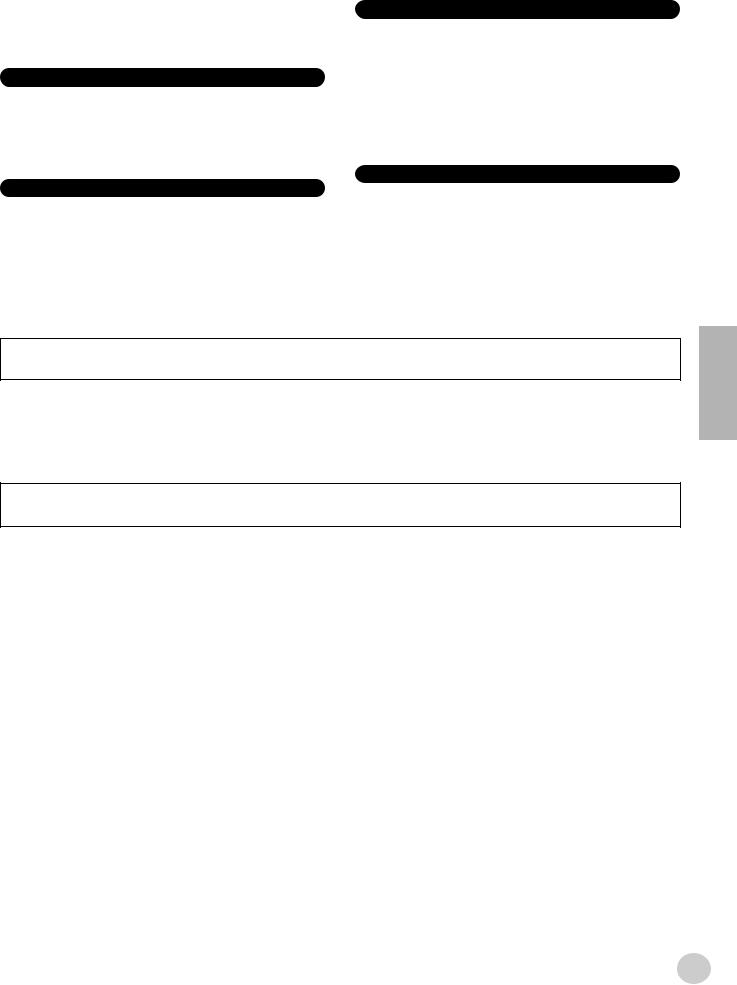
•Do not place the instrument in an unstable position where it might accidentally fall over.
•Before moving the instrument, remove all connected adaptor and other cables.
Connections
•Turn off the power to all other electronic components to which the instrument is to be connected before connecting the instrument. Also, be sure to lower all volume settings on all connected components to minimum, then gradually increase the volume while playing the instrument to set the desired listening level.
Handling caution
•Do not insert a finger or hand in any gaps on the instrument.
•Do not place vinyl, plastic or rubber objects on the instrument, since this might discolor the panel.
•Do not rest your weight on, or place heavy objects on the instrument, and do not use excessive force on the buttons, switches or connectors.
•Do not operate the instrument for a long period of time at a high or uncomfortable volume level, since this can cause permanent hearing loss. If you experience any hearing loss or ringing in the ears, consult a physician.
|
|
|
Saving data |
|
|
|
|
Maintenance |
Saving and backing up your data |
||
|
|
||
•When cleaning the instrument, use a soft, dry cloth. Do not use paint thinners, solvents, cleaning fluids, or chemical-impregnated wiping cloths.
•Data in the instrument’s internal memory can be lost due to operational errors or malfunction. Be sure to save any important data to external media via a computer connected to the instrument.
Yamaha cannot be held responsible for damage caused by improper use or modifications to the instrument, or data that is lost or destroyed.
Always turn the power off when the instrument is not in use.
When using a power adaptor, even when the power switch is in the “STANDBY” position, electricity is still flowing to the instrument at the minimum level. When you are not using the instrument for a long time, make sure you unplug the AC power adaptor from the wall AC outlet.
Make sure to discard used batteries according to local regulations.
The illustrations and LED display as shown in this owner’s manual are for instructional purposes only, and may be different from the ones on your instrument.
● Trademarks
•Apple and Macintosh are trademarks of Apple Computer, Inc., registered in the U.S. and other countries.
•Windows is the registered trademark of Microsoft® Corporation.
All other trademarks are the property of their respective holders.
(4)-8 2/2
3
EZ-AG 5
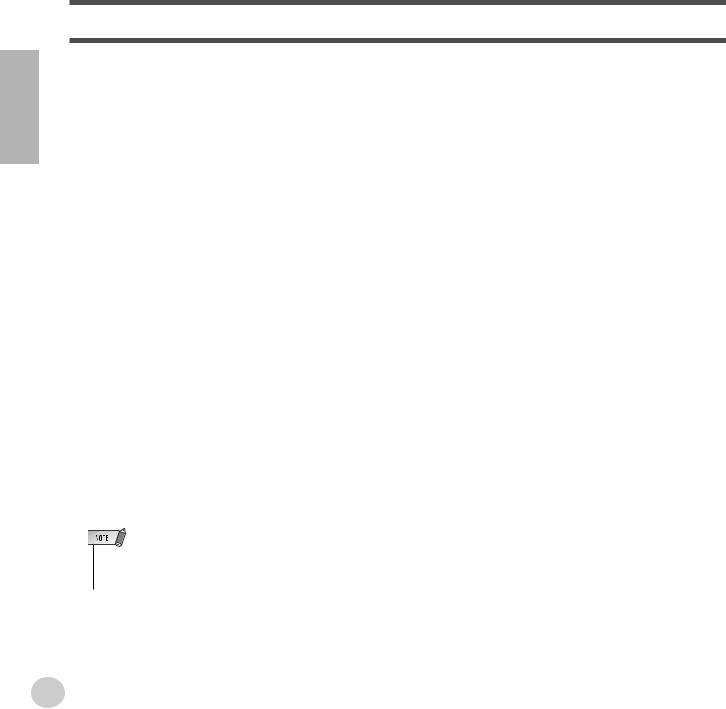
Thank you for choosing a Yamaha EZ GUITAR (EZ-AG)!
For maximum performance and enjoyment,
please read this owner's manual carefully before using your EZ-AG. When you're done reading the manual,
please store it in a safe place – along with the warranty card – for future reference.
Main Features
The EZ-AG is a sophisticated yet easy-to-use instrument. Some of its main features and functions include:
•Built-in amplifier and speaker.
•Automatic accompaniment featuring a range of popular songs and chord progressions. (See Page 12)
•Using the STRUM play mode you can play complete songs using only your right hand! (See Page 18)
•The CHORD play mode indicates the fingering for the chords you should play on the EZ-AG’s illuminated frets – an ideal practice and learning tool! (See Page 19)
•New songs can be downloaded from the internet using your computer, then transferred to and played on the EZ-AG! (MIDI interface required see page 22)
•Play using a wide range of different sounds. (See Page 12)
•No tuning required! The EZ-AG is always in perfect tune from the moment you turn it on. You can also select alternate tunings such as drop D and open G. (See Page 14)
•A “virtual capo” can be applied up to the sixth fret. (See Page 14)
•Since the EZ-AG uses switches rather than actual strings over frets, playing techniques that depend on the physical properties of strings – such as string bending, vibrato produced by string bending, and harmonics – are not possible.
4
6 EZ-AG
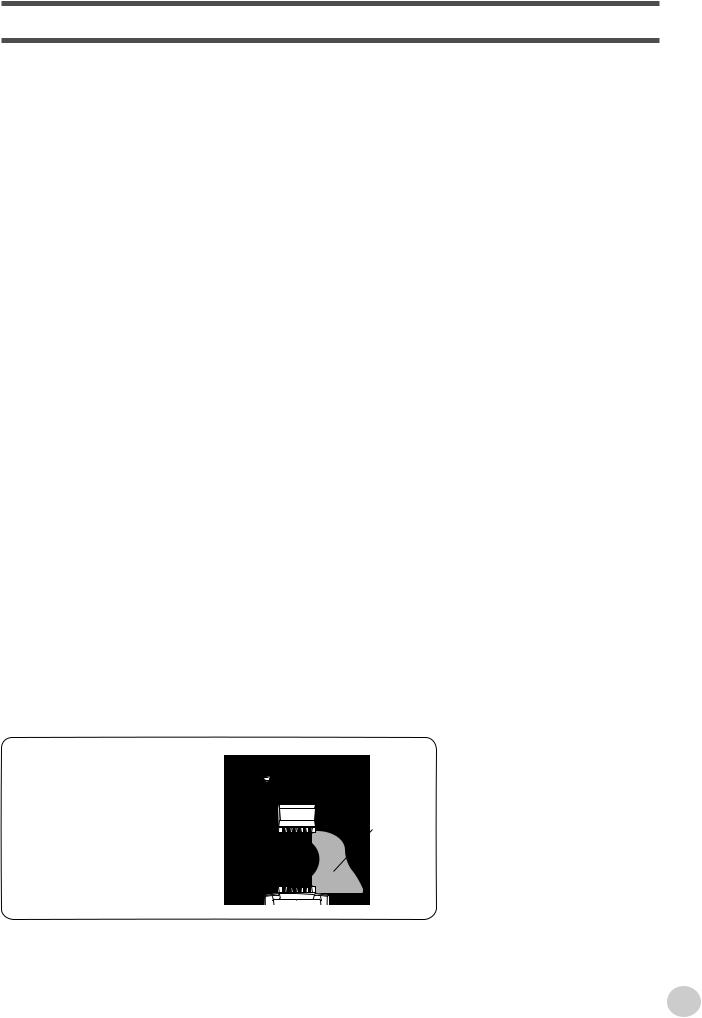
Contents
Names Of the Parts, Controls, |
|
.........................Connecting To MIDI Devices |
20 |
|
and Connectors ............................................... |
8 |
• What is MIDI?................................................... |
20 |
|
Setting Up |
10 |
• Some Example MIDI Applications .................... |
20 |
|
• Connecting To a Computer |
21 |
|
||
• Power Requirements |
10 |
|
||
• Loading Song Data Into the EZ-AG Using the |
|
|
||
• Connections |
11 |
|
|
|
Song Filer Application |
22 |
|
||
Playing the EZ-AG |
12 |
|
||
• Turning Local Control On or Off ....................... |
23 |
|
||
• Power On & Play .............................................. |
12 |
• Setting the MIDI Clock |
23 |
|
|
|
|
||
• Selecting Different Sounds ............................... |
13 |
Troubleshooting |
24 |
|
• Using the CAPO Function |
14 |
|
||
|
|
|
||
• Tuning............................................................... |
14 |
MIDI Implementation Chart ........................... |
26 |
|
Playing the Songs.......................................... |
15 |
Song Chord Chart .......................................... |
30 |
|
• Listen To the Songs and Play Along................. |
15 |
Commonly-used Chords |
33 |
|
• Listen To a Specified Song and Play Along |
16 |
|
||
Specifications |
34 |
|
||
• Change the Song Tempo.................................. |
16 |
|
||
|
||||
• Adjust the Balance............................................ |
17 |
|
|
|
Play Along With the Songs ........................... |
18 |
|
|
|
• PLAY 1: STRUM............................................... |
18 |
|
|
|
• PLAY 2: CHORD .............................................. |
19 |
|
|
|
• PLAY 3: BOTH.................................................. |
19 |
|
|
|
|
|
|
||
|
|
|
|
|
The pickguard-shape seal is provided for in-store promotional purposes, and may peel off or be scratched when the instrument is played.
Pickguardshape seal
5
EZ-AG 7
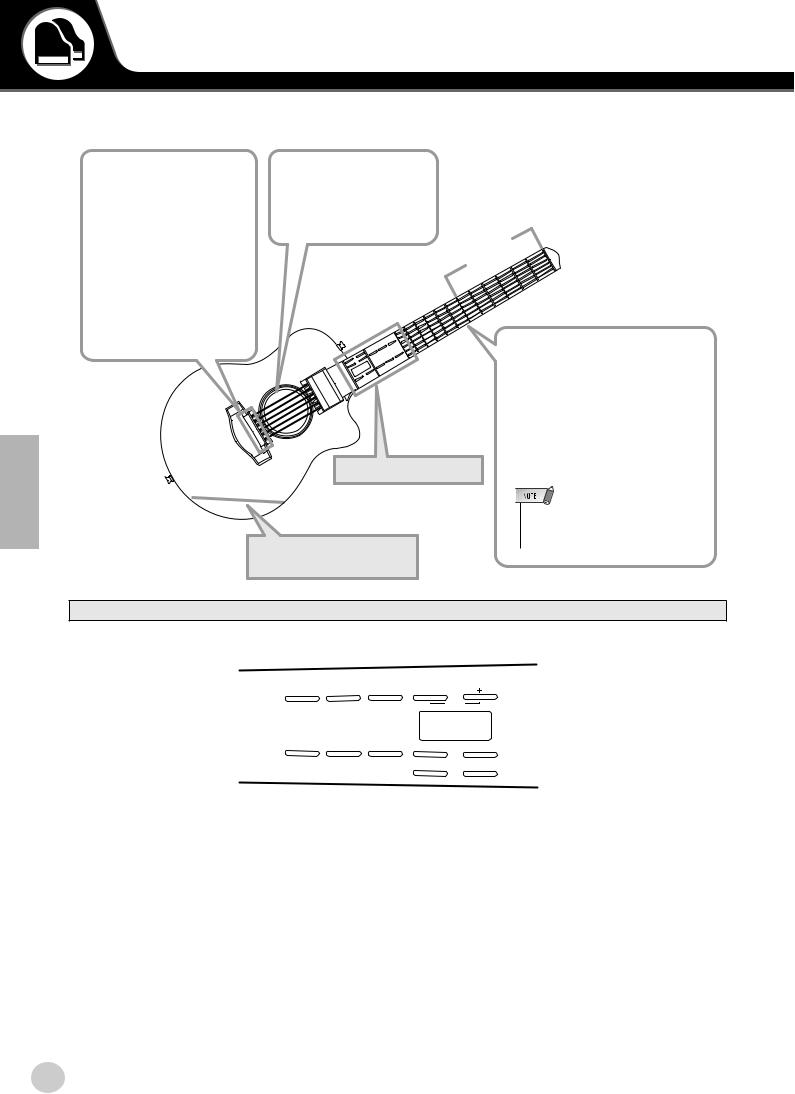
Names Of the Parts, Controls, and Connectors
■ Body
Bridge Plate
Strings that are sounding can be muted by touching the bridge plate with side or heel of the right hand. Be sure to touch the plate on the back of the neck with your left hand while touching the bridge plate with your right hand (See Page 12.)
Strings
The strings can be played either with a pick or finger style.
LED
Control Section
Frets
EZ-AG frets 1 through 6 are illuminated and will glow red when pressed. When the PLAY MODE is set to CHORD or BOTH, the appropriate frets will glow to indicate the frets you should press.
• When the CAPO function is used an entire column of frets will glow at the
capo position.
Connector &
Power Switch Section
Control Section
|
|
|
|
!0 |
|
|
|
|
|
|
|
|
|
q |
|
|
|
|
|
|
|
|
|
||||
|
|
|
|
|
|
|
|
|
|
|
|
|
|
|
|
|
|
|
|
|
|
|
|
|
|
|
|
|
|
1 |
PLAY |
MODE |
|
3 |
|
|
|
|
|
|
|
VALUE |
|
|
|
|
|
|
|
|
|
||||
|
|
|
|
2 |
|
|
|
|
|
|
|
|
|
|
|
|
|
|
|
|
|
|
|||||
|
|
|
|
|
|
|
|
|
|
|
|
|
|
|
|
||||||||||||
|
|
STRUM |
CHORD |
|
BOTH |
|
|
|
|
|
RESET |
|
|
|
|
|
|
|
|
|
|||||||
|
|
START/STOP |
START/STOP |
START/STOP |
|
|
|
|
|
|
|
|
|
|
|
|
|
|
|
|
|
||||||
|
|
|
|
|
|
|
|
|
|
|
|
00.0.. |
|
|
|
|
|
w |
|||||||||
|
|
|
|
|
|
|
|
|
|
|
|
|
|
|
|
|
|||||||||||
|
|
|
|
|
|
|
|
|
|
|
|
TEMPO |
VOLUME |
|
|
|
e |
||||||||||
|
|
DEMO |
|
SOUND |
|
|
SONG |
|
|
|
|
|
|
|
|
|
|
|
|
|
|
|
|
|
|||
|
|
|
|
|
|
|
|
CAPO |
|
TUNING |
|
|
|
||||||||||||||
|
|
|
|
|
|
|
|
|
|
|
|
|
|
||||||||||||||
|
|
START/STOP |
|
SELECT |
|
|
SELECT |
|
|
|
|
|
|
|
|
|
|||||||||||
|
|
|
|
|
|
|
|
|
|
|
|
|
|
|
|
|
|
|
|
|
|
|
|
|
|
|
|
|
|
|
|
|
|
|
|
|
|
|
|
|
|
|
|
|
|
|
|
|
|
|
|
||||
|
|
o |
|
i |
|
u |
|
|
y t |
|
|
|
|
|
|
|
r |
||||||||||
|
|
|
|
|
|
|
|
|
|
|
|
|
|||||||||||||||
q VALUE [+]/[-] Buttons |
|
|
|
|
|
|
|
|
w Display |
|
|
|
|
|
|||||||||||||
|
|
|
|
|
|
|
|
|
|
|
|
|
|||||||||||||||
These buttons are used to select sounds and songs as |
|
|
Displays the value of the parameter being edited, as |
||||||||||||||||||||||||
well as adjust tempo, volume, balance, and other |
|
|
|
|
|
well as the currently selected tempo. |
|||||||||||||||||||||
parameters. Press the [+] button once to increment |
|
|
|
|
|
e [VOLUME] Button |
|||||||||||||||||||||
the value by one, or press the [-] button once to decre- |
|
|
|||||||||||||||||||||||||
|
|
This button allows adjustment of both the instru- |
|||||||||||||||||||||||||
ment the value by one. Holding either button causes |
|
|
|||||||||||||||||||||||||
|
|
ment’s overall volume, and the balance between the |
|||||||||||||||||||||||||
continuous incrementing or decrementing in the cor- |
|
|
|||||||||||||||||||||||||
|
|
played and accompaniment sound. |
|||||||||||||||||||||||||
responding direction. Press both the [+] and |
[-] but- |
|
|
||||||||||||||||||||||||
|
|
|
|
|
|
|
|
|
|
|
|
|
|
|
|
|
|
||||||||||
tons simultaneously to reset the initial default value |
|
|
|
|
|
|
|
|
|
|
|
|
|
|
|
|
|
|
|||||||||
for the selected parameter. |
|
|
|
|
|
|
|
|
|
|
|
|
|
|
|
|
|
|
|
|
|
|
|
|
|||
|
|
|
|
|
|
|
|
|
|
|
|
|
|
|
|
|
|
|
|
|
|
|
|
|
|
|
|
6
8 EZ-AG
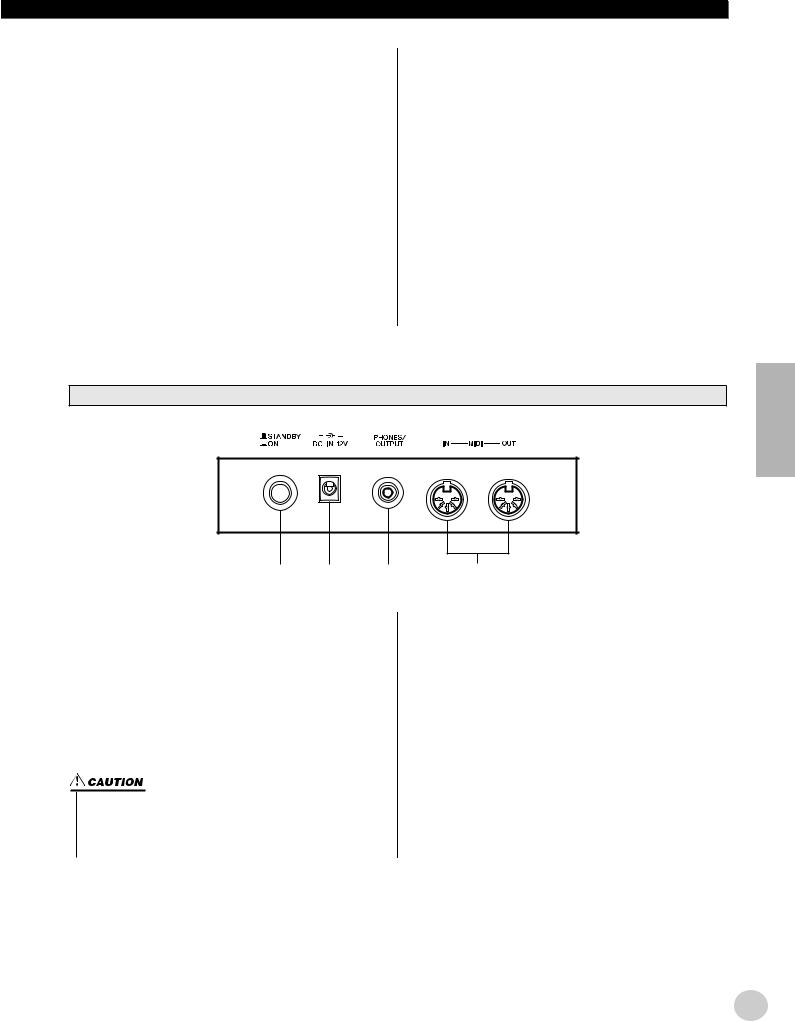
Names Of the Parts, Controls, and Connectors
r [TUNING] Button
Allows overall tuning of the EZ-AG in semitone increments, as well as selection of one of the EZAG’s alternative tunings: in addition to standard guitar tuning the EZ-AG provides drop-D, open-D, open-G, and open-E tunings.
t [TEMPO] Button
Allows the song tempo to be set from q=32 through q=280.
y [CAPO] Button
Allows the position of the EZ-AG’s “virtual capo” to be specified.
u [SONG] Button
Allows any of the 25 internal songs to be selected for playback. In addition to the songs initially provided, songs downloaded from the internet to a computer can be read into and stored in the EZ-AG.
i [SOUND] Button
Allows selection of any of the EZ-AG’s 20 instrument sounds.
o [DEMO] Button
Starts and stops song playback.
!0[STRUM], [CHORD], [BOTH] Buttons
Starts playback of the selected song using the corresponding playback method.
Connector & Power Switch Section
q w e
q Power Switch ([STANDBY/ON])
This is the EZ-AG power switch. Press the switch in to turn the power ON. Press the switch again to return it to the extended STANDBY position and turn power off.
w DC IN 12V Jack
The AC Power Adaptor (PA-3C) can be connected here.
•Make sure that power to all external devices is OFF when connecting the EZ-AG to avoid possible electric shock and damage to the equipment. Also, start with all volume controls turned down to minimum to prevent possible damage to speakers and other playback equipment.
r
e PHONES/OUTPUT Jack
This jack can be used to connect a pair of stereo headphones for private practice or listening, or to connect the EZ-AG to an audio system, television, or instrument amplifier.
r MIDI IN/MIDI OUT Connectors
These connectors can be used to connect the EZ-AG to other MIDI gear or a computer using standard MIDI cables.
7
EZ-AG 9
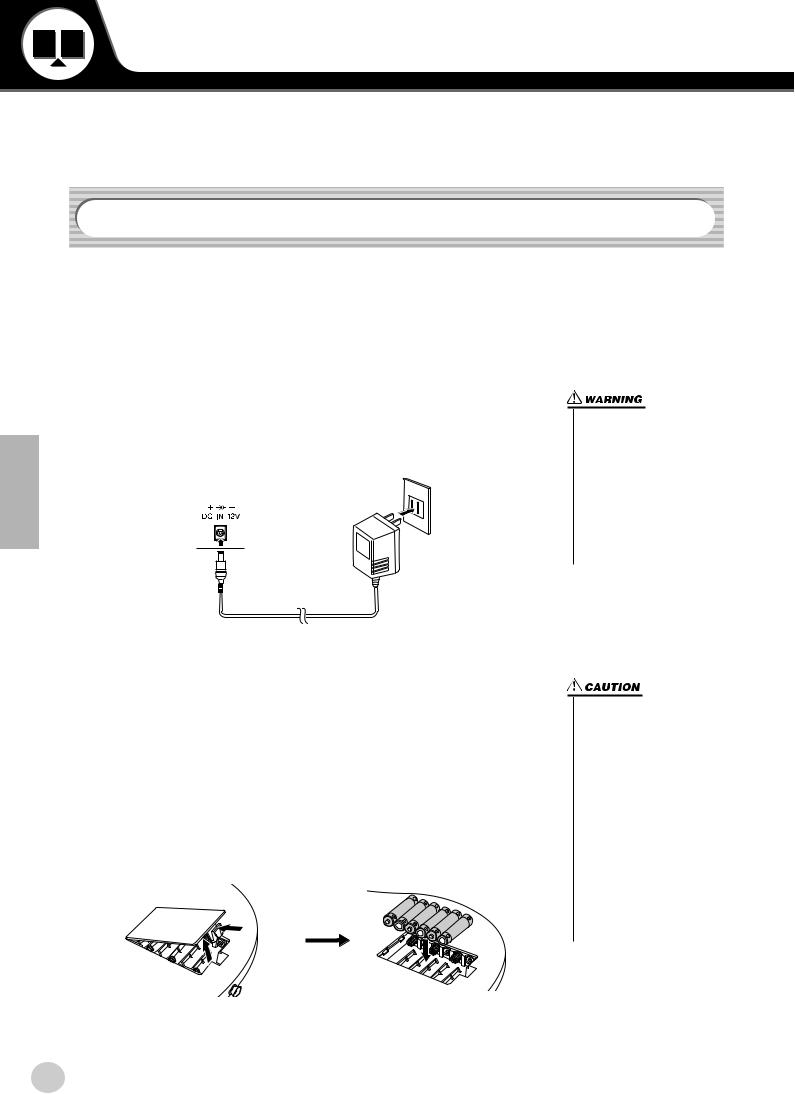
Setting Up
This section contains information about setting up your EZ-AG for playing. Make sure to read this section carefully before using the instrument.
Power Requirements
Although the EZ-AG will run either from an optional AC adaptor or batteries, Yamaha recommends use of an AC adaptor whenever possible. An AC adaptor is more environmentally friendly than batteries and does not deplete resources.
■ Using an AC Power Adaptor • • • • • • • • • • • • • • • • • • • • • • • • •
q Make sure that the [STANDBY/ON] switch of the EZ-AG is set to STANDBY.
wConnect the AC adaptor (PA-3C, PA-3B, or other adaptor specifically recommended by Yamaha) to the DC IN 12V jack.
e Plug the AC adaptor into an AC outlet.
AC Adaptor
PA-3C
■ Using Batteries • • • • • • • • • • • • • • • • • • • • • • • • • • • • • • • • • •
For battery operation the EZ-AG requires six 1.5V “AA” size, or LR6 or equivalent batteries. When the batteries need to be replaced, the volume may be reduced, the sound may be distorted, and other problems may occur. When this happens, turn the power off and replace the batteries, as described below
q Open the battery compartment cover located on the instrument’s bottom panel.
wInsert the six new batteries, being careful to follow the polarity markings in the battery compartment.
e Replace the compartment cover, making sure that it locks firmly in place.
•Use ONLY a Yamaha PA-3C or PA-3B AC Power Adaptor (or other adaptor specifically recommended by Yamaha) to power your instrument from the AC mains. The use of other adaptors may result in irreparable damage to both the adaptor and the EZ-AG.
•Unplug the AC Power Adaptor when not using the EZ-AG, or during electrical storms.
•Use only alkaline batteries for this instrument. Other types of batteries (including rechargable batteries) may have sudden drops of power when battery power becomes low, possibly resulting in loss of data in the flash memory and the need to initialize the flash memory.
•When the batteries run down, replace them with a complete set of six new batteries.
NEVER mix old and new batteries.
•If the instrument is not to be in use for a long time, remove the batteries from it, in order to prevent possible fluid leakage from the battery.
8
10 EZ-AG
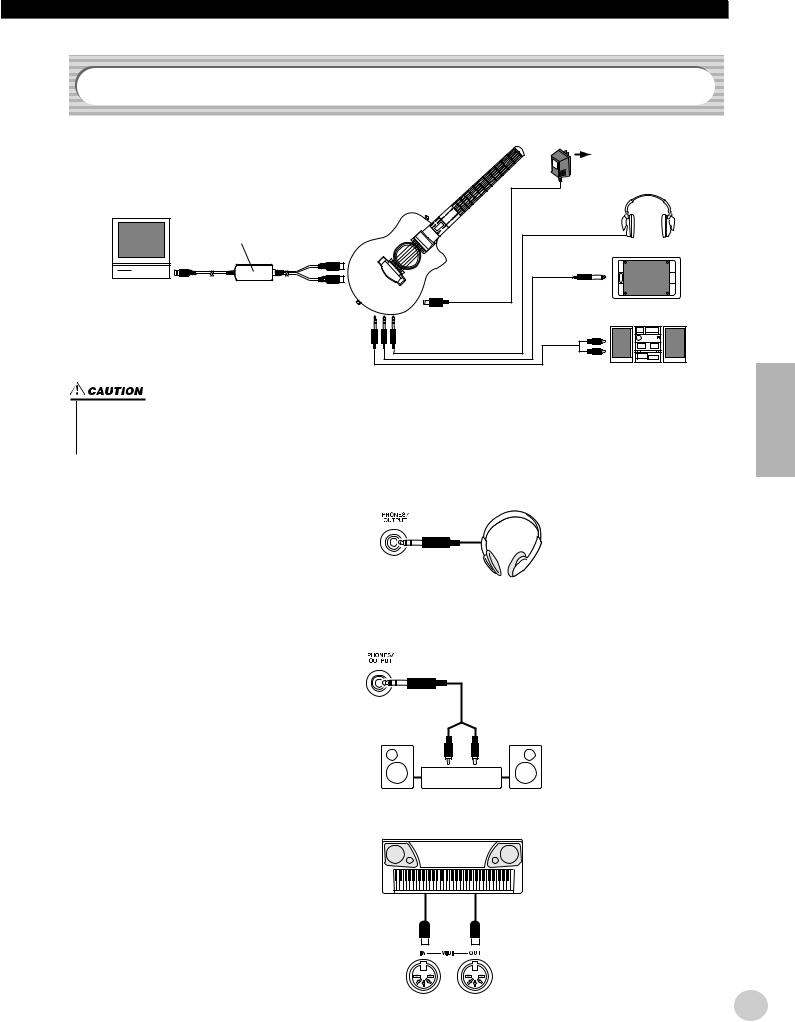
Setting Up
Connections
Refer to “Connecting To a Computer” on page 21 for connection details.
Computer
USB-MIDI Interface
USB
Connector
To AC wall socket
EZ-AG |
Headphones |
AC Power Adaptor
MIDI OUT Connector |
|
Powered Speaker |
|
|
Standard |
||
|
|
Phone Plug |
|
MIDI IN Connector |
DC IN 12V |
|
|
Connector |
|
||
|
|
||
PHONES/OUTPUT |
|
Audio System, |
|
|
Television, etc. |
||
Connector |
|
||
Stereo |
RCA Pin Plugs |
||
|
|||
|
|
||
|
Phone Plug |
|
•Make sure that power to all external devices is OFF when connecting the EZ-AG to avoid possible electric shock and damage to the equipment. Also, start with all volume controls on external devices turned down to minimum to prevent possible damage to speakers and other playback equipment.
■Using Headphones• • • • • • • • • • • • • • • • • • • • • • • • • • • • • • • •
For private practicing and playing without dis-
turbing others, connect a set of stereo headphones to the PHONES/OUTPUT jack. Sound from the built-in speaker system is automatically cut off when you insert a headphone plug into this jack.
■ Connecting To an External Amplifier or Stereo System • • • • •
Though the EZ-AG is equipped with a built-in speaker system, you can also play it through an external amplifier/speaker system. First, make sure the EZ-AG and any external devices are turned off, then connect one end of a stereo audio cable to the LINE IN or AUX IN jack(s) of the other device and the other end to the PHONES/OUTPUT jack on the EZ-AG.
Stereo System
■ Using the MIDI Terminals • • • • • • • • • • • • • • • • • • • • • • • • • • •
The EZ-AG also features MIDI terminals, allowing you to interface the EZ-AG with other MIDI instruments and devices.
MIDI instrument
9
EZ-AG 11
